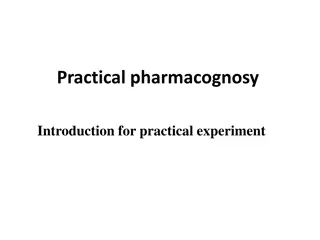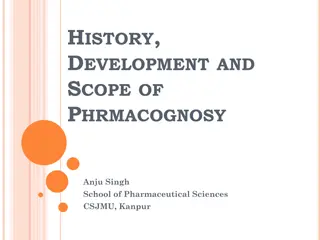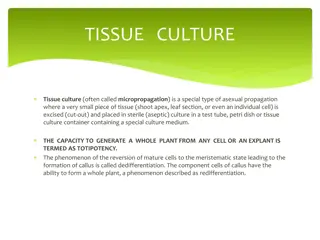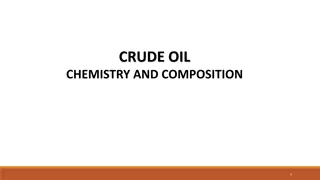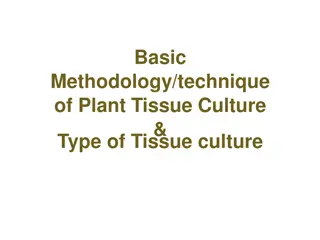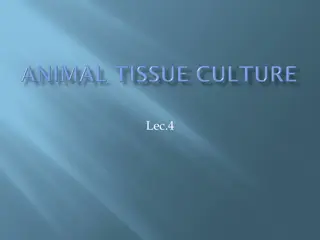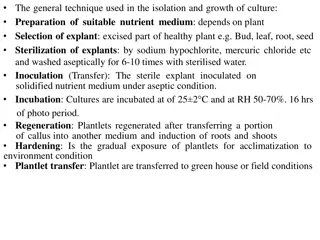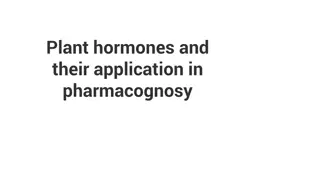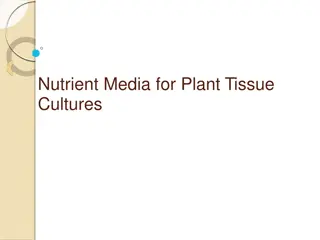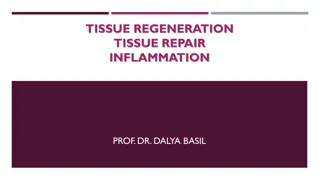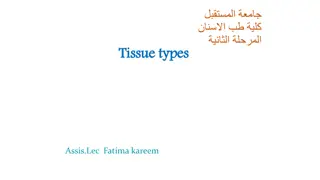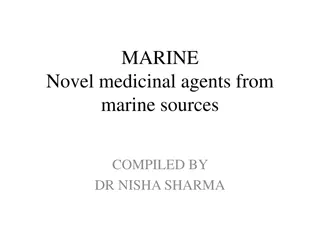Sources of Crude Drugs: Plant, Animal, Marine, and Tissue Culture in Pharmacognosy
Crude drugs are natural substances obtained from plants, animals, and minerals. They are used without much processing and have therapeutic properties. Different plant parts like leaves, flowers, fruits, seeds, roots, bark, and stems yield various important drugs. Animals and minerals also serve as sources of essential drugs. Understanding these sources is crucial in pharmacognosy and phytochemistry studies in the pharmaceutical field.
Download Presentation

Please find below an Image/Link to download the presentation.
The content on the website is provided AS IS for your information and personal use only. It may not be sold, licensed, or shared on other websites without obtaining consent from the author. Download presentation by click this link. If you encounter any issues during the download, it is possible that the publisher has removed the file from their server.
E N D
Presentation Transcript
Sources of Crude Drugs Plant, Animal, Marine and Tissue Culture FOR B.PHARMA VI SEMESTER SUBJECT PHARMACOGNOSY AND PHYTOCHEMISTRY BY : DR.DARSHAN DUBEY
Sources of Crude Drugs CRUDE DRUGS Crude drugs are the drugs, which are obtained from natural sources like plant, insects, animals and minerals. They should be used as such as they occur in nature without any processing except, collection, drying and size reduction. Crude drugs are also defined as drugs that have not been advanced in value or improved in condition by shredding, grinding, chipping, crushing, distilling, evaporating, extracting, artificial mixing with other substances or any other process beyond that which is essential to its proper packing and to prevention of decay or deterioration during manufacturing. Crude drugs and their constituents are commonly used as therapeutic agents. Source of crude drugs are plant (senna, opium, digitalis and Clove), Animal (Musk, Honey, Shark liver Oil) and Mineral (Shilajit, Talc, Bentonite).
Drugs are obtained from six major sources: 1. Plant sources 2. Animal sources 3. Mineral/ Earth sources 4. Microbiological sources 5. Recombinant DNA technology/ Tissue culture 6. Semi synthetic sources/ Synthetic sources 1. Higher plants as sources of crude drugs Plant source is the oldest source of drugs. Most of the drugs in ancient times were derived from plants. Almost all parts of the plants are used i.e. leaves, stem, bark, fruits and roots. Significant number of synthetic drugs obtained from natural precursors.
A. Leaves: The leaves of Digitalis Purpurea are the source of Digitoxin and Digoxin, which are cardiac glycosides. Leaves of Eucalyptus give oil of Eucalyptus, which is important component of cough syrup. Tobacco leaves give nicotine. Atropa belladonna gives atropine. B. Flowers: Poppy Papaver somniferum gives morphine (opoid) Vinca rosea gives vincristine and vinblastine Rose gives rose water used as tonic. C. Fruits: Senna pod gives anthracine, which is a purgative (used in constipation) Calabar beans give physostigmine, which is cholinomimetic agent.
D. Seeds: Seeds of Nux Vomica give strychnine, which is a CNS stimulant. Castor oil seeds give castor oil. Calabar beans give Physostigmine, which is a cholinomimetic drug. E. Roots: Ipecacuanha root gives Emetine, used to induce vomiting as in accidental poisoning. It also has amoebicidal properties. Rauwolfia serpentina gives reserpine, a hypotensive agent. Reserpine was used for hypertension treatment. F. Bark: Cinchona bark gives quinine and quinidine, which are antimalarial drugs. Quinidine also has antiarrythmic properties. Atropa belladonna gives atropine, which is anticholinergic. Hyoscyamus Niger gives Hyosine, which is also anticholinergic. G. Stem: Chondrodendron tomentosum gives tuboqurarine, which is skeletal muscle relaxant used in general anesthesia
2. Animal as source of drug Certain animal parts and animal products are used as drug in therapeutic. The major group of animal products used in medicine is hormone, enzyme, animal extractives organs and bile acids. Second largest source of crude drugs. Pancreas is a source of Insulin, used in treatment of Diabetes. Urine of pregnant women gives human chorionic gonadotropin (hCG) used for the treatment of infertility. Sheep thyroid is a source of thyroxin, used in hypertension. Cod liver is used as a source of vitamin A and D.
Anterior pituitary is a source of pituitary gonadotropins, used in treatment of infertility. Blood of animals is used in preparation of vaccines. Stomach tissue contains pepsin and trypsin, which are digestive juices used in treatment of peptic diseases in the past.
3. Marines as a source of drugs Major part of earth is covered with water bodies and hence bioactive compounds from marine flora and fauna (microorganisms, algae, fungi, invertebrates, and vertebrates) have extensive past and present use in the treatment of many diseases. Serve as compounds of interest both in their natural form and as templates for synthetic modification. Several molecules isolated from various marine organisms are currently under study.
Number of anticancer, anti-inflammatory, cardio tonic chemical moieties are isolated from marine plants and animals. Example: Agar-agar, a popular pharmaceutical excipient, from red algae, Carrageenans or carrageenins (linear sulfated polysaccharides) from red seaweeds. Cephalosporin a antimicrobial agents obtained from the marine fungus Cephalosporium acrimonium. Antiparasitic compound Domoic acid obtained from red algae Chondria armata.
4. Mineral Sources: Drugs from mineral source include both metallic an non-metallic substances like kaolin, talc, bentonite, shilajit, asbestos etc. Metallic and Non metallic sources: Iron is used in treatment of iron deficiency anemia. Mercurial salts are used in Syphilis. Zinc is used as zinc supplement. Zinc oxide paste is used in wounds and in eczema. Iodine is antiseptic. Iodine supplements are also used. Gold salts are used in the treatment of rheumatoid arthritis
5. Miscellaneous Sources: Fluorine has antiseptic properties. Borax has antiseptic properties as well. Selenium as selenium sulphide is used in anti dandruff shampoos. Petroleum is used in preparation of liquid paraffin.
6. Microbiological Sources: The microbes are microscopic organism which include viruses, bacteria and reckettsiae Small pox vaccine (viral vaccine) contains living virus of vaccinia (cow pox) which has been grown in the skin of a vaccinated bovine calf. Rabies vaccine is a sterile preparation of killed, fixed virus of rabies obtained from duck embryos. Typhoid vaccine (bacterial vaccine) it is a sterile suspension containing killed selected strain of typhoid bacilli, salmonella typhi used for producing immunizing agent typhoid fever.
BCG vaccine is a dried living culture of the bacilus calmette. Plague vaccine which is used to produce immunity against the disease, is a sterile suspension of killed selected strain of plague bacillis. Cholera vaccine is a sterile suspension of killed cholera, vibrio. Toxoids such as tetanus toxoid and diptheria toxoids. Measles virus contains live attenuated rubeola and rubella viruses.
Penicillium notatum is a fungus which gives penicillin. Actinobacteria give Streptomycin. Aminoglycosides such as gentamicin and tobramycin are obtained from streptomycis and micromonosporas. 7. Tissue culture / Recombinant DNA technology as source of drugs Culture is term generally used for artificial growth. It involves in-vitro multiplication of cells, tissues and organs on defined solid or liquid media under aseptic and controlled environment.
Multiplication of cells, tissues and organs on defined solid or liquid media under aseptic and controlled environment. Plant tissue culture as source of Drugs S. No 1 Secondary Metabolites Reserpine Plant Source Types of Culture Suspension Culture Cell Culture Hairy root Culture Callus Culture Suspension Culture Suspension Culture Root Culture Suspension Culture Rawolfia serpentina 2 3 4 5 Viblastin Atropine Rhein Nicotine Catharanthus roseus Atropa belladona Cassia angustifolia Nicotina tobacum 6 Morphine Papaver somniferum 7 8 Quinine Digoxin C. Ledgeriana Digitalis lanata
Recombinant DNA Technology - Recombinant DNA technology involves cleavage of DNA by enzyme restriction endonucleases. The desired gene is coupled to rapidly replicating DNA (viral, bacterial or plasmid). The new genetic combination is inserted into the bacterial cultures which allow production of vast amount of genetic material. Interliukin 2 for certain types of cancer. Beta endorphins foe treatment of pains. TPA tissue plasminogen activator for treating heart attack. Somatostatin for treatment of pituitary diseases.
8. Synthetic/ Semi synthetic Source i. Synthetic Sources: When the nucleus of the drug from natural source as well as its chemical structure is altered, we call it synthetic. Examples include Emetine Bismuth Iodide ii. Semi Synthetic Source: When the nucleus of drug obtained from natural source is retained but the chemical structure is altered, we call it semi-synthetic. Examples include Apomorphine, Diacetyl morphine, Ethinyl Estradiol, Homatropine, Ampicillin and Methyl testosterone. Most of the drugs used nowadays (such as antianxiety drugs, anti convulsants) are synthetic forms.
References Text Book of Pharmacognosy and Phytochemistry by Biren N. Shah and A.K. Seth published by ELSEVIER, First edition, 2010. Text Book of Pharmacognosy and Phytochemistry I by Sanjay Setia, Dr Praveen Kumar and Atul Kabra published by S.Vikas and Company,2019. Pharmacognosy by C.K. Kokate, A.P. Purohit and S.B. Gokhale published by Nirali Prakashan, 27 edition,2004. http://www.bspublications.net http:// howmed.net/sources-of-drugs
http://www.bspublications.net http:// howmed.net/pharmacology/sources-of-drugs


